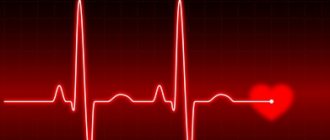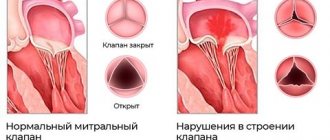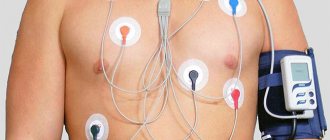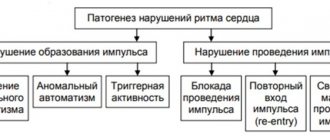Atrial fibrillation is a heart rhythm disorder manifested by an irregular heartbeat or an increase in heart rate to 350–700 beats per minute. The pathology is usually diagnosed in adulthood and is most often caused by organic heart disease. The Cardiology Department of the Elena Malysheva Clinic carries out diagnosis and treatment of atrial fibrillation in the elderly, taking into account the individual characteristics of the body. Based on the examination results, our experienced doctors will prescribe adequate therapy that will improve the patient’s general condition.
Causes of atrial fibrillation
Atrial fibrillation develops against the background of cardiac pathologies. Diseases can be congenital or acquired during life.
The most common pathologies that can lead to the development of atrial fibrillation are:
- Primary hypertension.
- Heart disease.
- Heart valve damage.
- Atrial septal defects.
- Cardiomyopathy of unspecified etiology.
- Atherosclerosis of the coronary arteries.
- Sinus tachycardia.
- Cardiac ischemia.
- Heart failure of acute or chronic course.
Atrial fibrillation often develops after pericarditis or myocarditis. Surgical interventions on the heart or coronary arteries can also trigger the development of the disorder.
Atrial fibrillation is not always a consequence of pathologies of the cardiovascular system. Sometimes the disorder develops against the background of thyroid disease, when a hormonal imbalance occurs in the body. Also, disturbances in the functioning of the heart can be caused by kidney pathologies, liver damage, and airway obstruction. All of these diseases do not often lead to the development of atrial fibrillation, but this possibility should not be excluded.
Increases the likelihood of developing atrial fibrillation apnea. The risks increase when apnea develops against the background of high blood pressure and diabetes. Apnea leads to increased pressure in the atria, negatively affects their size, and disrupts the functioning of the autonomic nervous system.
What's the forecast?
The prognosis for life with atrial fibrillation is determined primarily by the causes of the disease. For example, for survivors of acute myocardial infarction and significant cardiosclerosis, the short-term prognosis for life can be favorable, but for health in the medium term unfavorable, since in a short period of time the patient develops chronic heart failure, which worsens the quality of life and shortens it duration.
However, with regular use of medications prescribed by a doctor, the prognosis for life and health undoubtedly improves. And patients with a permanent form of MA registered at a young age, with proper compensation, live with it for up to 20-40 years.
Risk factors for developing atrial fibrillation
Separately, we can identify risk factors that increase the likelihood of developing atrial fibrillation.
These include:
- Alcohol abuse.
- Smoking.
- Drug addiction.
- Poisoning with toxic substances.
- Therapy with antibiotics, cardiac glycosides, corticosteroid hormones, dopamine blockers. Atrial fibrillation will develop when treatment is carried out without proper medical supervision.
- Private stress and nervous tension.
- Age. The older a person is, the higher his likelihood of developing arrhythmia. This is due to a decrease in the number of cardiomyocytes, as well as disruptions in intercellular connections in the myocardium, which negatively affects the conduction of impulses.
The younger the person, the lower his risk of developing atrial fibrillation. However, most people over 50 years of age experience disturbances in myocardial function. Particular caution should be exercised in relation to patients who have a genetic predisposition to cardiac pathologies.
- Excessive physical and mental stress.
- Obesity and diabetes.
- Chronic obstructive pulmonary disease.
- Maintaining a sedentary lifestyle.
- Errors in nutrition. Arrhythmia can develop if a person receives little potassium and magnesium from foods. It is these microelements that the heart muscle needs to maintain health.
To exclude the possibility of developing heart pathology in patients who are forced to take medications for a long time, it is necessary to regularly undergo ultrasound examination of the organ.
There are also products that must be present on every person’s menu. They saturate the body with useful substances and help maintain normal heart function.
Such products include:
- Leafy salads, particularly arugula, lettuce and Chinese lettuce.
- Any greens: rosemary, dill, parsley, cilantro.
- Eggplants, tomatoes, cabbage, spinach.
- Boiled or baked potatoes. The vegetable needs to be cooked with its peel on.
- Dried fruits compote.
- River fish.
- Nuts. Brazil nuts and pine nuts are very good for the heart.
- Cod liver.
- Seafood.
- Legumes: lentils, peas, beans.
- Dairy products.
If a person cannot eat a balanced diet, then he needs to see a doctor and, together with him, decide on the need to take vitamin-mineral complexes. Drugs such as Panangin and Asparkam can help the heart. Independent use of these medications is unacceptable, as they have a number of contraindications.
Types of atrial fibrillation
Experts distinguish 5 types of arrhythmia, which differ not only in symptoms, but also in the duration of the attack:
- Paroxysmal.
- Persistent.
- Long-term persistent.
- Constant.
- Non-valvular.
During diagnosis, it is important to correctly determine the type of atrial fibrillation, since the success of therapy depends on this.
Most often, patients are diagnosed with a paroxysmal form of atrial fibrillation. It lasts no more than a week. If the attack has not been stopped within 2 days, then it will not stop on its own, but the likelihood of developing systemic thromboembolism is extremely high. In such situations, doctors talk about chronic or persistent arrhythmia.
Depending on the heart rate, the following types of arrhythmia are distinguished:
- Heart rate is greater than or equal to 90 beats per minute - tachysystolic arrhythmia.
- Heart rate 60-90 beats per minute – normosystolic arrhythmia.
- Heart rate is less than or equal to 60 beats per minute - bradysystolic arrhythmia.
The maximum heart rate for atrial fibrillation is 600 beats per minute. This is a critical indicator at which the patient develops an ischemic infarction. It will definitely happen if the attack is not stopped within 2 days from its onset.
Persistent atrial fibrillation may not resolve on its own. It lasts more than 7 days. To cope with the disorder, medical assistance is needed.
Long-term persistent arrhythmia is said to occur when it lasts more than a year. In this case, drug therapy is a mandatory direction of treatment. An ablation method can also be used.
Persistent atrial fibrillation is said to occur when it can be maintained, or when previous drug treatment or surgery has failed.
Atrial fibrillation
One of the most common types of supraventricular tachyarrhythmias is atrial fibrillation (AF). Fibrillation is a rapid, irregular contraction of the atria, with a frequency exceeding 350 beats per minute. The onset of AF is characterized by irregular contraction of the ventricles. AF accounts for more than 80% of all paroxysmal supraventricular tachyarrhythmias. Atrial fibrillation is possible in patients of all age categories, but in elderly patients the prevalence of the syndrome increases, which is associated with an increase in organic heart pathology.
Symptoms of atrial fibrillation
Symptoms of atrial fibrillation will vary among different types of patients. What matters is the patient’s age, his lifestyle, the form of the disorder, and his state of health. Although there are still general symptoms of this cardiopathology.
These include:
- Pulse instability. A person can independently understand that the heart is beating abnormally, but to confirm the diagnosis, a 12-lead ECG is required. The first signs of atrial fibrillation can be considered an ischemic stroke or transient ischemic attack.
- Heartache. During an attack, patients indicate pain in the heart area. She always focuses on the left side. The pain can be dull, sharp, or stabbing, burning or pressing. The patient is always able to clearly describe the location of the pain, since it does not spread to other parts of the body.
- Breathing problems. Patients with atrial fibrillation complain of shortness of breath. Many patients indicate that they experience pain in the heart when they try to take a breath. If the patient begins to move, the painful sensations gain strength.
Shortness of breath develops regardless of a person’s level of physical activity. It can happen at night when he is at rest.
If the heart rate exceeds 100 beats per minute, shortness of breath can become very intense and even provoke attacks of suffocation in the patient. An attack of asphyxia lasts 5-7 minutes, so most people do not consult a doctor about this. This should not be done, since an advanced disorder can result in arrhythmogenic shock and even cardiac arrest.
- Cramps and tremors in the limbs. Seizures and tremors are two different concepts. If a person has convulsions, then he experiences involuntary muscle contraction. In this case, the limbs do not move. When a patient has tremors, shaking of the affected areas is always observed.
If we consider cramps and tremors in the limbs against the background of arrhythmia, then patients most often complain of symptoms such as:
- Cramps in the calf area. Most often they develop at night, during sleep.
- Tremor of hands, feet, neck, head.
- Tingling and numbness of the limbs.
- Muscle weakness. Muscle weakness very often accompanies various forms of arrhythmia. Its severity varies widely. The lower and upper extremities are primarily affected. Sometimes it is difficult for the patient to dress himself or wash the dishes, and he may drop objects. More than half of people indicate weak feet and deterioration in the sensitivity of the feet.
After drug therapy is started, tremors and convulsions cease to bother the patient.
Muscle weakness due to heart disease is not a constant phenomenon, it occurs from time to time. Discomfort increases after a person is immobilized for a long time: sitting or standing. Slow blood flow can also cause limb weakness.
- Increased sweating. Even with minor physical exertion, a person will sweat a lot. A similar situation occurs during emotional stress. The patient sweats both during the day and at night when he sleeps. The sweat is liquid, not sticky. It has the same temperature as the human body temperature.
- Increased amount of urine excreted. As a rule, increased urine output is observed no longer than 1-2 days. Daily diuresis increases to 1.8-2 liters, while normally these figures are 1.5 liters maximum. Severe arrhythmia may be accompanied by an increase in daily diuresis of up to 3 liters. The person himself suffers from severe thirst, his mouth becomes dry.
- Mental disorder. The patient's irritability increases, he becomes anxious, he is haunted by fears that he is unable to explain. Many people begin to experience a fear of death that is impossible to get rid of.
Complications of atrial fibrillation
Atrial fibrillation in 35% of cases turns into ventricular fibrillation, which increases the likelihood of developing a heart attack and stroke, as well as acute cardiac ischemia.
More than 70% of patients with atrial fibrillation suffer from heart failure. In 20-30% of patients, dysfunction of the left ventricle of the heart develops.
Severe atrial fibrillation threatens arrhythmogenic shock and cardiac arrest.
Atrial fibrillation is associated with risks of cognitive impairment and vascular dementia.
the disease requires treatment, otherwise the consequences can be very serious, even death. It is important to focus efforts on eliminating those factors that led to heart rhythm disturbances. To make a diagnosis, you need to contact a cardiologist.
The connection between atrial fibrillation and stroke
Against the background of atrial fibrillation, the likelihood of developing a stroke increases. In women, the risks increase by 2 times, and in men by 1.5 times. Some experts believe that stroke occurs in all patients with atrial fibrillation. Other scientists are of the opinion that the risk is increasing, but is not 100%.
If a person takes blood thinning medications, the likelihood of developing a stroke is reduced. However, fibrillation negatively affects the blood supply to the brain. The patient may experience blood stasis in the parts of the heart, which leads to the formation of blood clots in it. They are able to migrate through blood vessels with the blood flow. If these clots reach the brain, the person has a stroke.
Taking anticoagulants helps prevent strokes, so these drugs are prescribed to all patients suffering from atrial fibrillation. It must be remembered that blood thinners can cause bleeding if taken over a long period of time. However, the risk of blood loss is significantly lower than the risks associated with a stroke.
Any medications that contain acetylsalicylic acid thin the blood and prevent the formation of blood clots.
Warfarin is the most commonly prescribed drug used to treat patients with atrial fibrillation. Therapy with this drug should be monitored by blood counts. To do this, the patient will need to regularly visit a specialist and undergo tests. Based on their results, the dose is adjusted.
Drug therapy
The following areas of drug therapy for atrial fibrillation are distinguished: cardioversion (restoration of normal sinus rhythm), prevention of repeated paroxysms (episodes) of supraventricular arrhythmias, control of the normal frequency of contractions of the ventricles of the heart. Another important goal of drug treatment for MA is the prevention of complications - various thromboembolisms. Drug therapy is carried out in four directions.
Treatment with antiarrhythmics.
It is used if a decision has been made to attempt drug cardioversion (restoring the rhythm with the help of drugs).
The drugs of choice are propafenone, amiodarone.
Propaphenone
is one of the most effective and safe drugs used to treat supraventricular and ventricular heart rhythm disorders. The action of propafenone begins 1 hour after oral administration, the maximum concentration in the blood plasma is reached after 2–3 hours and lasts 8–12 hours.
Heart rate control.
If it is impossible to restore the normal rhythm, it is necessary to bring the atrial fibrillation back to normal form. For this purpose, beta-blockers, non-dihydropyridine calcium antagonists (verapamil group), cardiac glycosides, etc. are used.
Beta blockers
. Drugs of choice for controlling heart function (frequency and strength of contractions) and blood pressure. The group blocks beta-adrenergic receptors in the myocardium, causing a pronounced antiarrhythmic (heart rate reduction) as well as hypotensive (blood pressure reduction) effect. Beta blockers have been shown to statistically increase life expectancy in heart failure. Contraindications for use include bronchial asthma (since blocking beta 2 receptors in the bronchi causes bronchospasm).
Anticoagulant therapy.
To reduce the risk of thrombosis in persistent and chronic forms of AF, blood thinning drugs must be prescribed. Anticoagulants of direct (heparin, fraxiparin, fondaparinux, etc.) and indirect (warfarin) action are prescribed. There are regimens for taking indirect (warfarin) and so-called new anticoagulants - antagonists of blood clotting factors (Pradaxa, Xarelto). Treatment with warfarin is accompanied by mandatory monitoring of coagulation parameters and, if necessary, careful adjustment of the drug dosage.
Metabolic therapy.
Metabolic drugs include drugs that improve nutrition and metabolic processes in the heart muscle. These drugs purport to have a cardioprotective effect, protecting the myocardium from the effects of ischemia. Metabolic therapy for MA is considered an additional and optional treatment. According to recent data, the effectiveness of many drugs is comparable to placebo. Such medicines include:
- ATP (adenosine triphosphate);
- K and Mg ions;
- cocarboxylase;
- riboxin;
- mildronate;
- preductal;
- mexico.
Diagnosis and treatment of any type of arrhythmia requires considerable clinical experience, and in many cases, high-tech hardware. In case of atrial fibrillation and flutter, the main task of the doctor is, if possible, to eliminate the cause that led to the development of the pathology, preserve heart function and prevent complications.
Treatment of atrial fibrillation
Restoration of sinus rhythm is required for patients in the following cases:
- Developmental paroxysmal atrial fibrillation.
- Falling blood pressure, heart failure, shortness of breath and other negative manifestations of atrial fibrillation.
- There is a high probability that the restored sinus rhythm can be maintained. This is possible in cases where atrial fibrillation developed less than a year ago.
Depending on the type of atrial fibrillation, the patient must undergo certain preparatory measures:
- Provided that the attack of atrial fibrillation lasts no more than 2 days, preliminary preparation for restoring sinus rhythm is not required. Unfractionated heparin is used before and after cardioversion. In Europe, treatment can be carried out using Heparin or Apixaban. Sometimes cardioversion is performed without the use of blood thinners at all. This is possible if the likelihood of developing blood clots is minimal.
- Heparin is used without fail if the patient has disturbances in the movement of blood through the vessels.
- If atrial fibrillation continues in a patient for more than 48 hours and its causes have not been established, then the patient is advised to take anticoagulants before undergoing cardioversion. In Russia, Warfarin is most often used, and in European countries - Dabigatran. The patient receives therapy for 21 days before cardioversion and 28 days after its completion. Dabigatran is recommended for use in patients diagnosed with non-valvular fibrillation. The duration of treatment should be at least 3 weeks.
- Alternatively, the patient may undergo transesophageal echocardioscopy before undergoing cardioversion. This procedure allows you to detect already formed blood clots. If they are not available, then cardioversion is carried out under the guise of heparin therapy. When a blood clot is detected, the patient is prescribed Warfarin for 3 weeks. Transesophageal echocardioscopy is then performed again.
When atrial fibrillation is diagnosed, all patients over 65 years of age should receive anticoagulants. Most often they are prescribed in tablet form, since such therapy is more convenient for treatment on an outpatient basis.
Warfarin is the drug of choice for patients with atrial fibrillation. It was developed back in 1924 and was used as a poison to kill rats.
Warfarin can only be prescribed by a doctor. Self-medication is unacceptable, since the drug cannot be used with many medications. The prognosis of the disease is determined by how accurately the patient follows the specialist’s recommendations and adheres to the frequency of Warfarin administration.
The initial dose of the drug is 2.5-5 mg. It is taken in the evening, between 17:00-19:00. At the stage of selecting the optimal dosage, blood parameters (international normalized ratio) are monitored daily. Blood sampling is carried out in the morning from 9:00-11:00. Starting from the second week of therapy, control is performed 2 times a week, and then once a month. Once a month, the patient will need to take a urine sample for a general analysis.
The BAFTA study found that Warfarin therapy compared with Aspirin therapy reduced the likelihood of developing a stroke by 52%. However, as an option, the patient can receive combination treatment with Aspirin and Clopidogrel. This therapy is prescribed if it is not possible to regularly donate blood for analysis while undergoing treatment with Warfarin.
Both Warfarin and Aspirin increase the risk of bleeding, but the effectiveness of the first drug is higher.
Patients are also prescribed therapy with new anticoagulants, but calling them “new” would not be entirely correct. Rather, they are classified as direct oral anticoagulants.
These are medicines such as:
- Dabigatran (Pradaxa). If the drug is used in a dosage of 150 mg, then its effectiveness compared to the effectiveness of Warfarin increases by 2 times (in terms of the development of stroke). However, the risk of bleeding becomes twice as high. A dosage of 110 mg, divided into 2 doses, is safer, but its effectiveness is equal to taking Warfarin.
- Rivaroxaban (Xarelto). This drug has similar characteristics to Dabigatran.
- Apixaban (Eliquis). The drug reduces the risk of death, and the results of taking it are better in terms of bleeding. It can be used by people with kidney failure.
Data provided from the RE-LY study.
Preventing the risk of blood clots
The patient may undergo therapy aimed at reducing the likelihood of blood clots:
- Intravenous administration of heparin at a dosage of 4000-5000 units.
- Subcutaneous injection of low molecular weight heparins (Flenox, Clexane, Fraxiparine) in a dosage of 0.2-0.4 ml.
- Use of Warfarin at a dosage of 5 mg/day. The drug is prescribed after an acute attack of atrial fibrillation has been eliminated. Alternatively, the patient can be prescribed Dabigatran at a dosage of 150 mg 2 times a day. The drug is taken orally.
- It is possible to prescribe antiplatelet agents: Aspirin, Cardiomagnyl, Aspecard, Clopidogrel.
Drugs to restore sinus rhythm
If it is possible to restore sinus rhythm with medications, then drugs such as:
- Amiodarone. This is one of the most effective drugs, but it cannot be prescribed to patients with heart failure. Heart rhythm is restored within a day from the start of therapy. The dose is 5 mg/kg body weight, which is administered over an hour. Then the patient is transferred to 50 mg per hour.
- In the department of anesthesiology and intensive care, Nibentan can be administered to the patient, but it can cause tachycardia such as pirouette.
- In Europe, drugs such as Ibutilide and Vernakalant are used. However, these drugs are not registered in Russia.
- For cardioversion with drugs in our country, only Procainamide can be used. It is administered intravenously at a dosage of 500-1000 mg once.
If the patient has developed atrial fibrillation not too long ago and does not have cardiac pathology of an organic nature, then any of the medications listed above can be used. Procainamide is used only under ECG and blood pressure monitoring. If there is damage to the heart muscle, then preference should be given to a drug such as Amiodarone.
Beta blockers, Verapamil, Digoxin, Aymalin, Sotalol will not achieve the desired effect. In terms of carrying out drug cardioversion, they are useless.
In past years, Quinidine was widely used for atrial fibrillation. However, it was found that this drug in atrial fibrillation increases the likelihood of death by 3-5 times.
Electrical cardioversion
Treatment of atrial fibrillation with current discharges is one of the most effective methods of therapy. A high-voltage pulse of electric current is passed through the patient's heart once. This procedure allows you to reboot the myocardium and stabilize the heart rhythm.
The effect of such therapy is equal to 95%. The charge power is 100-200 kJ. Sometimes the procedure is performed with access to the heart through the esophagus. However, such a procedure is associated with a high risk of severe complications and even complete cardiac arrest.
Radiofrequency catheter ablation
Radiofrequency catheter ablation is one of the optimal methods for treating atrial fibrillation. During the procedure, the doctor destroys the source that provokes the appearance of unnecessary impulses in the heart. In this case, the operation is performed with closed access.
First, the specialist determines the changed area of the heart. Then a catheter is passed through the femoral artery, which is a source of electrical impulses. They are the ones who destroy the pathological focus.
Maintaining a stable heart rate
It is not enough to simply eliminate disturbances in the functioning of the heart; it is important to make these results fixed. If the patient does not receive treatment, then in 45-85% of cases atrial fibrillation recurs no later than a year after cardioversion.
Medicines used to maintain normal sinus rhythm:
- Beta blockers (Metoprolol). These drugs are most often prescribed to older patients.
- Antiarrhythmic drugs are recommended for use by patients with heart failure.
- If ablation is planned for young patients with atrial fibrillation in the future, then an antiarrhythmic drug is indicated before surgery. These are drugs such as: Amiodarone, Etatsizin, Disopyramide, Flecainide, Propafenone, Sotalol, Dronedarone.
- The drug of choice for chronic heart failure is Amiodarone.
- In other cases, preference is given to Sotalol, Dronedarone, and Propafenone.
- Dronedarone is not prescribed to patients with heart failure, but it is effective in stabilizing heart rate in atrial fibrillation.
Heart rate control
In order to monitor heart rate in patients, they are advised to conduct a 24-hour ECG. For young people, the norm is a heart rate of 60-80 beats per minute at rest and 90-115 beats per minute during moderate exercise.
Drugs that can be used to control heart rate:
- Beta blockers: Metoprolol, Atenolol.
- Cardiac glycosides – Digoxin.
- Calcium channel blockers: Verapamil, Diltiazem.
- Antiarrhythmics – Dronedarone, Amiodarone.
You can combine beta blockers with cardiac glycosides and antiarrhythmics. If such therapy does not achieve an effect, then surgery is recommended for the patient.
To prevent the progression of atrial fibrillation, the patient is prescribed medications such as ACE inhibitors, statins and sartans.
Use of the drug Propanorm for AF
Relief of paroxysms
The strategy, called the “pill in the pocket,” is based on taking a loading dose of Propanorm, which allows you to restore the heart rhythm both in hospital and outpatient treatment. According to many placebo-controlled studies, the effectiveness of a single oral dose of 450-600 mg of propafenone ranges from 56 to 83% (Boriari G, Biffi M, Capucci A, et al., 1997). According to the all-Russian study "PROMETHEUS", which involved 764 patients with recurrent atrial fibrillation, the effectiveness of the loading dose of the drug was 80.2%.
Prevention of paroxysms
The strategy is based on taking the drug daily to prevent paroxysms. The multicenter, open-label, randomized, prospective comparative study "Prostor" provided the following preliminary results.
- Propanorm® does not lead to a deterioration in hemodynamic parameters in patients with arterial hypertension, coronary heart disease and chronic heart failure with preserved systolic function. The use of the drug for atrial fibrillation for prophylactic purposes helps reduce the number of hospitalizations associated with circulatory decompensation by 72.9%.
- The antiarrhythmic effectiveness of Propanorm after 12 months from the start of administration is almost equal to the indicators when using Cordarone - 54.2% and 52.9%, respectively.
- In the absence of post-infarction cardiopathy (ejection fraction less than 40%), Propanorm® can be used as an antiarrhythmic drug, including in combination with beta-blockers, if necessary.
- Propanorm® has a better safety profile compared to Cordarone.
To maintain sinus rhythm in patients diagnosed with recurrent atrial fibrillation, the recommended daily dose for continuous use of Propanorm is 450 mg (3 times a day) or 600 mg (2 times a day). With frequent occurrence of paroxysms, it is possible to increase the dose to 900 mg (3 times a day).
Types of surgical intervention for atrial fibrillation
- Isolation of the left atrium from the conduction system of the heart. During the procedure, doctors are forced to disconnect the heart chamber, which increases the likelihood of blood clots.
- Pacemaker installation. This device is aimed at blocking pathological impulses, which allows you to maintain a normal heart rhythm.
- Introduction of a pacemaker. This device independently reboots the heart when its rhythm is disrupted.
- Operation labyrinth. During the procedure, the doctor makes multiple incisions on the heart, creating an artificial labyrinth in its left sections. It prevents the conduction of pathological impulses to the ventricles. This type of surgery is not performed often, as it requires the patient to be connected to a heart-lung machine.
- Operation corridor. It comes down to the fact that the atria are isolated from the conduction system, forming a passage to the ventricles.
- Radiofrequency ablation. In this case, the pulmonary veins are isolated from the pathways that are responsible for conducting electrical impulses. This treatment method is used when drug correction does not achieve the desired success, or if the patient has had previous cases of thromboembolism. Ablation is also performed if there are contraindications to the implementation of endovascular catheter techniques.
Emergency care for patients with an acute attack of atrial fibrillation
If a person knows that he may have an attack of atrial fibrillation, then he should be able to provide first aid to himself. These activities are carried out until the medical team arrives.
They are called vagal tests:
- Sinus massage. The patient lies on his back, finds the carotid artery in the neck and gently massages it clockwise.
- Pressure on the eyeballs.
- Stimulation of the cough reflex.
- Valsalva maneuver: you need to take a deep breath and tense your abdominal muscles.
- Pressure on the root of the tongue to induce vomiting.
Forecast for life
The prognosis of atrial fibrillation largely depends on the form of the disease. Most often, disorders occur in the form of attacks that are repeated over many years. As a result, the disease becomes chronic. If the heart rate during attacks rises to 300-600 beats per minute, then the prognosis worsens.
Atrial fibrillation is life-threatening and aggravates the course of the underlying heart disease.
The prognosis can be considered more favorable in the case when, against the background of arrhythmia, no disturbances are observed in the functioning of the myocardium. For many years, the patient may not notice attacks of atrial fibrillation at all. The more regularly the attacks occur, the lower the person’s quality of life.
Diagnostics
Atrial fibrillation is diagnosed based on:
- collection and analysis of anamnesis;
- detection of characteristic complaints of the patient himself;
- detection of certain specific changes in standard electrocardiogram recordings.
Electrocardiographic signs of the pathology in question are as follows:
- Multiple f waves are detected, confirming atrial fibrillation (flickering). This type of wave may differ in amplitude, shape and other characteristics;
- the recordings completely lack P waves, which are necessarily detected in normal sinus heart rhythm;
- while the QRS complexes are preserved, a chaotic violation of the RR intervals is observed.
In addition, when performing standard electrocardiography, doctors have the opportunity to determine the patient’s associated cardiac pathology that provokes rhythm disorders. Also, to establish an accurate diagnosis and detect all concomitant pathologies, doctors can use diagnostic techniques such as Holter monitoring, echocardiography, cardiac ultrasound, etc.
An example of paroxysmal atrial fibrillation on an ECG








